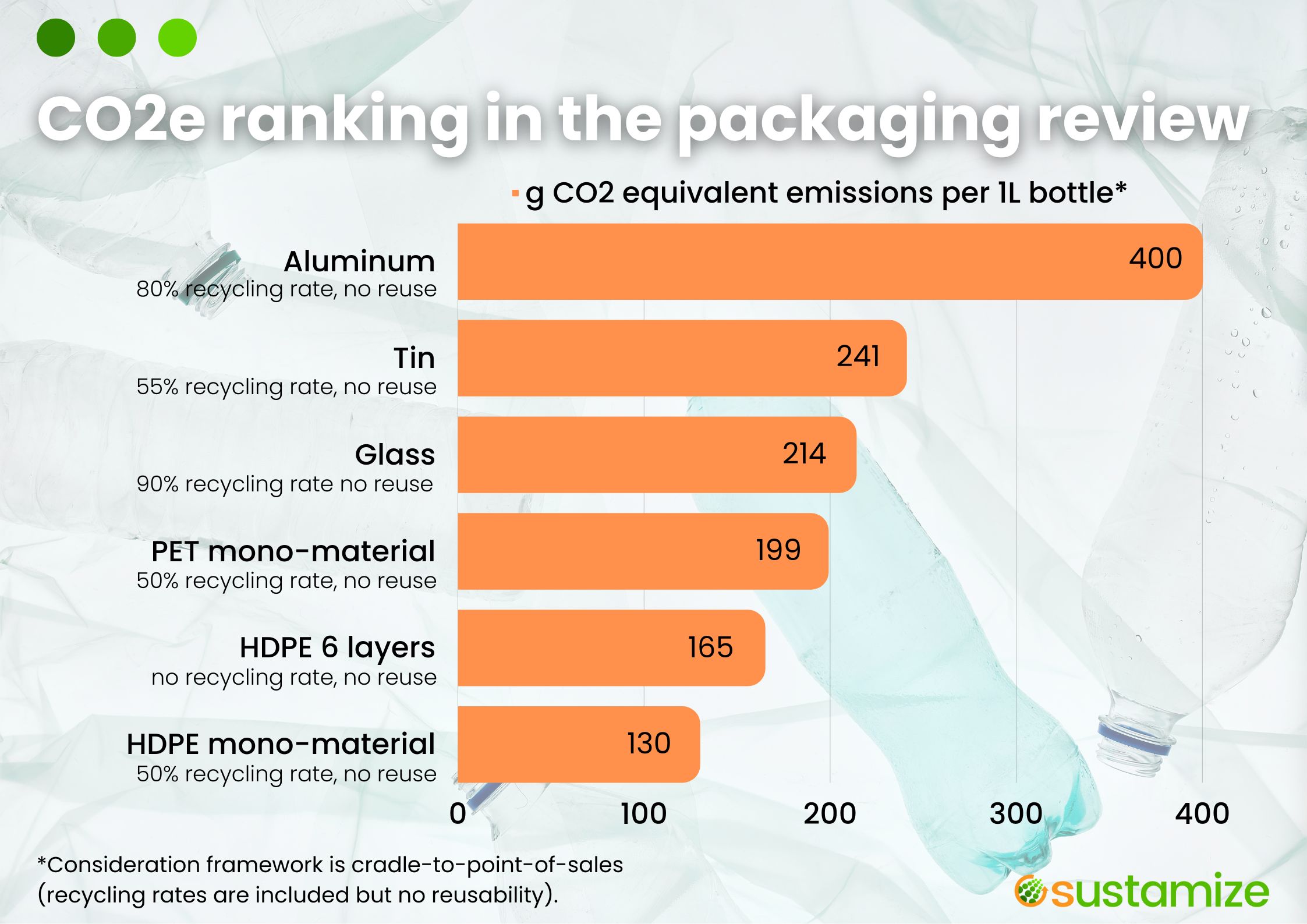Bottle packaging review in industry
In this review, we will focus on bottle packaging in the industrial sector.

Also in the industry companies buy packaging to transport important substances, liquids or other to their customers. These bottles can be made of different materials and, depending on businesses, can be returned in a reusable system. The impact on CO2e emissions will be analyzed below.
In the analysis, sustamize compares 1L bottles made of different materials, which are used in different industries for the transport or further processing of goods, such as beverages, fragrances, etc. The choice of packaging thus has a direct impact on the overall product carbon footprint. The choice of packaging thus has a direct impact on the overall product carbon footprint. The material has the greatest influence, but the weight of the packaging also determines the CO2e emissions during transport. In the food industry, for example, packaging accounts for 5-10% of the total product carbon footprint. Therefore, the right choice of packaging materials also plays a role in optimizing the footprint.
CO2-Ranking
For the comparison, the product carbon footprints are calculated using the sustamize bottom-up calculation method and the "cradle-to-point-of-sales" calculation framework of one 1-liter bottle each of HDPE mono-material, HDPE 6-layer, aluminum, tinplate, PET mono-material and glass.
The following assumptions are defined:
- All bottles, except the HDPE 6-layer bottle, are manufactured in Germany, as no other information is available from the other manufacturers. According to Kunz-Packaging, the HDPE 6-layer bottle is produced in France.
- The recycling rate describes the usual composition of the material from primary and recycled materials. The assumption about the proportion of primary material is defined either technically to avoid loss of quality (e.g. for aluminum) or because of usual recycling quantity in the market (Germany).
- All bottles are equipped with the same lid. The lid is made of 13 grams of HDPE and the sealing washer is made of one gram of Alu/PE. This is not reused, but consists of 50% recycled material. The gasket is made of primary material as it is not recyclable.
- Reuse frequency describes the assumed frequency of reuse of the bottle until it is recycled or banned.
- Transport distances are set at 500km on average to the filler and another 500km to the point of sale (POS).

Aluminum, saving the world?
Despite its high recycling rate, aluminum is far ahead in terms of CO2e emissions. Why is the material still promoted as a sustainable alternative compared to plastic? Jason Momoa, Games of Throne star says in his Youtube video: "Plastic is killing our planet". His solution is an aluminum can, arguing that it can be recycled indefinitely. However, there is always quality loss in a recycling process, so a 100% recycling rate is not achieved. Even if a high recycling rate can be ensured in the production of cans and bottles, the production and recycling of aluminum is disproportionately energy intensive. In energy-intensive processes, the choice of energy source used (conventional vs. regenerative) offers great potential for optimization.
Therefore, there is optimization potential in the choice of energy source used (conventional vs. regenerative). The calculation (chart 1) is based on a European average value of the electricity mix for the production of the primary material (the material added to ensure the quality of the bottle: 20%). Thus, the CO2e emission is 12.33 CO2e kg / kg of aluminum. If the aluminum comes from Norway with a higher share of renewable energy sources in the electricity mix, it is only 0.5 CO2e kg/ kg.
Glass vs. plastic - which is actually better?
The sustainability issue around plastic is of course much more complex than the pure CO2e consideration, because the problem of mass production exists. More plastic is constantly being put into circulation everywhere, and countries' recycling rates do not reflect the true situation. According to the German government, Germany is the "recycling champion" in Europe with a recycling rate for plastics from private households of 38%. In a study by Conversio, the rate is adjusted to 17.3% by uncontrolled waste exports after sorting and by other losses in the recycling process.
Glass has the potential to be the more sustainable alternative. But it depends very much on the electricity mix used in its manufacture. This is because the glass melting process is responsible for 64% of the total CO2e footprint. Thus, the total CO2e emissions can be significantly reduced via a greener electricity mix.
A reusable system that is also possible in industrial use?
The two HDPE variants are no longer far apart. It is assumed that, as with a PET bottle, the two HDPE variants will also be reused about 25 times. However, the packaging manufacturer has no influence on whether customers transfer the bottles to a returnable system. Not every company wants to make the extra effort of taking the bottles to the cleaning point.
However, if the bottles are not returned to a reusable system, the packaging review looks different.

With glass, CO2e emissions increase by only 7%. The difference is more serious for the plastic variants. CO2e emissions from the PET monomer 1-liter bottle increase 4.5-fold, from the HDPE 6-layer bottle 4-fold and from the HDPE monomer 3.6-fold.
What does this mean for the industry and the packaging manufacturer?
Manufacturers need to ensure at the product design stage that bottles can be made from recycled material and are themselves recyclable. This ensures that less primary material needs to be added. In addition, the energy-intensive manufacturing processes in particular can be disproportionately optimized with a regenerative electricity mix. To further avoid CO2e, bottles must be produced and used for a reusable system. One possibility is to standardize bottle shapes so that every industry can continue to use the bottle after cleaning. In addition, companies must be sensitized (incentivized) to use more reusable systems.
If you are interested in a CO2e ranking in your industry, feel free to contact us here.
Sources
Photo by Jasmin Sessler on Unsplash
https://www.quarks.de/umwelt/muell/darum-ist-aluminium-nicht-gut-fuer-die-umwelt/
https://dserver.bundestag.de/btd/19/046/1904634.pdf


.jpg)

